Stored

The series produces an eerie prediction for what's to come. "A day in summer 2020. Social isolation has become normal. The new disease is called hypochondria," says Roché.
Check out the rest of the series below.
Stay informed on our latest news!

The series produces an eerie prediction for what's to come. "A day in summer 2020. Social isolation has become normal. The new disease is called hypochondria," says Roché.
Check out the rest of the series below.











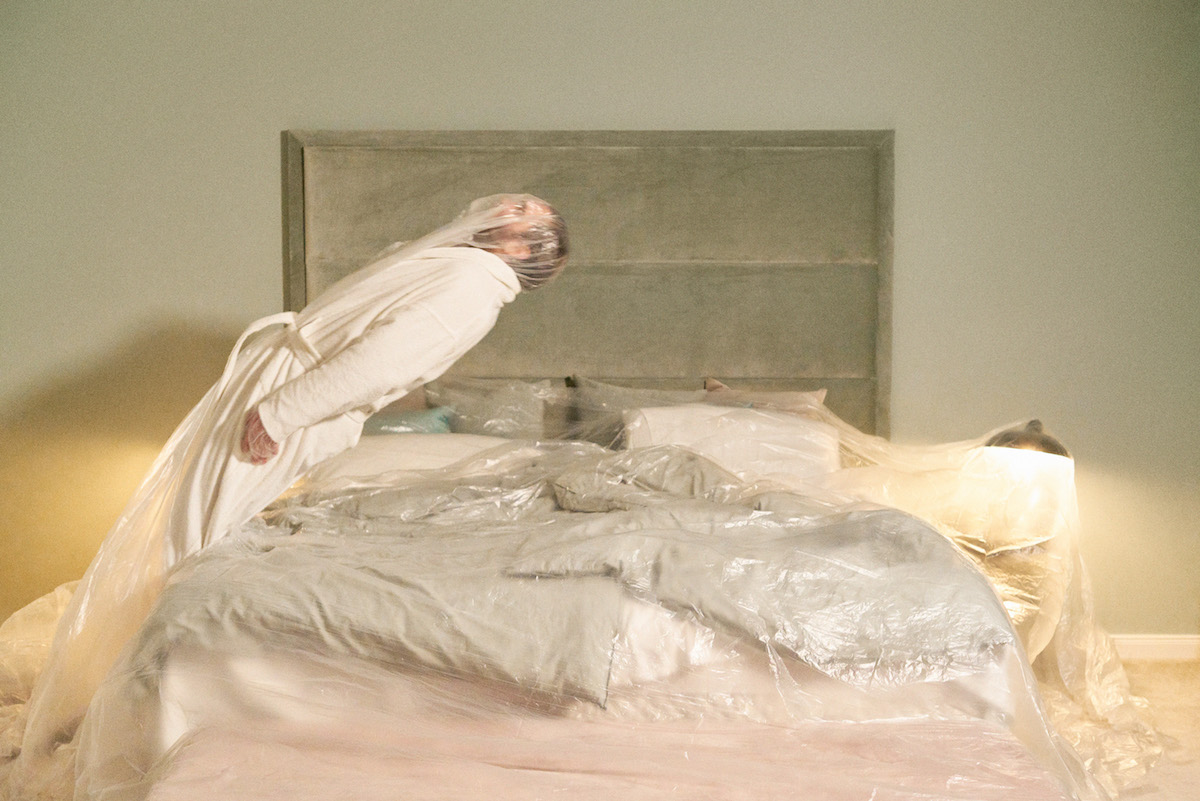


We can look at any one of Isaac’s pieces and understand almost immediately what it's about, or at least what we think it’s about. But that’s the beauty of Isaac’s work: no matter the subject matter, we see ourselves, or a friend, or someone we love in all of them. At just 21 years old, he has created a body of work reflective of the universal moments that connect us all.
Read our conversation about Isaac’s process and purpose as an artist below.
I feel like we’ve been in communication on and off since the days of the pandemic. Visually, I’ve seen your work change so much from four years ago to today. Do you feel like there was a switch in your life that resulted in this change?
Yes, for sure. I went to see this Jennifer Packer show at Serpentine in around 2021,and at the time I was doing quite abstract paintings – aesthetically they were pretty but they weren’t really saying much. I went to that show, and it made me fall in love with painting people. The way she paints people, it makes you feel this really deep connection. I thought it was really fascinating, and so I decided I wanted to start painting people. Before this change, my work was much more self-referential. I did self portraits, about mental health, and I used myself as the subject of my work. But around the start of 2023, I lost my very close friend, and that’s when my work really shifted towards this theme of human connection. So now, my work is about relationships, and moments of intimacy and human connection.
That’s super interesting. I see the conceptual shifts, and change in emotional approach to your work, but I also see a huge shift in the techniques you are using — all these lines that you create through negative space, and the vibrant use of color. Where did that come from?
Well, back when I was painting self-portraits, I wasn’t particularly good at drawing, so I was always drawing these very loose silhouettes with line work, and I liked it a lot but the colors weren’t quite right. I literally had to teach myself how to paint with oil — I was learning through YouTube — and one of the things it taught me was this process of doing a wash to stain your canvas. Most people paint over that wash, but I really liked that color and the tone it gives the whole canvas — it’s almost like a sepia photograph that feels really nostalgic. So I kept that color visible through the line work which massively changed the color palette of all my paintings. And not just the color of this process shows, but also the texture. Painting the canvas with this burnt umber and white mix, then washing it down with this very toxic turpentine creates this almost wood-like texture, making my paintings look like they’re printed on a wood block.
So you’re kind of allowing the process of the medium to show itself in the final piece.
Yeah, I just thought, it’s such a nice color, why get rid of it? And also, this color became the color for all the skintones in my pieces. With my current style, that is intentionally very 2D and very flat, the sepia wash and the line work replaces any shading, on faces or on things like draped clothes. In my paintings, I want there to be no evident light source, and the intention behind that is that my paintings are slightly disconnected from the real world, they aren’t real life. The figures aren’t real, none of them are real people. They are everyman type figures, so they can be universally understood. By doing this, you can understand what the human emotions of the painting are, while not assigning these emotions to specific people.
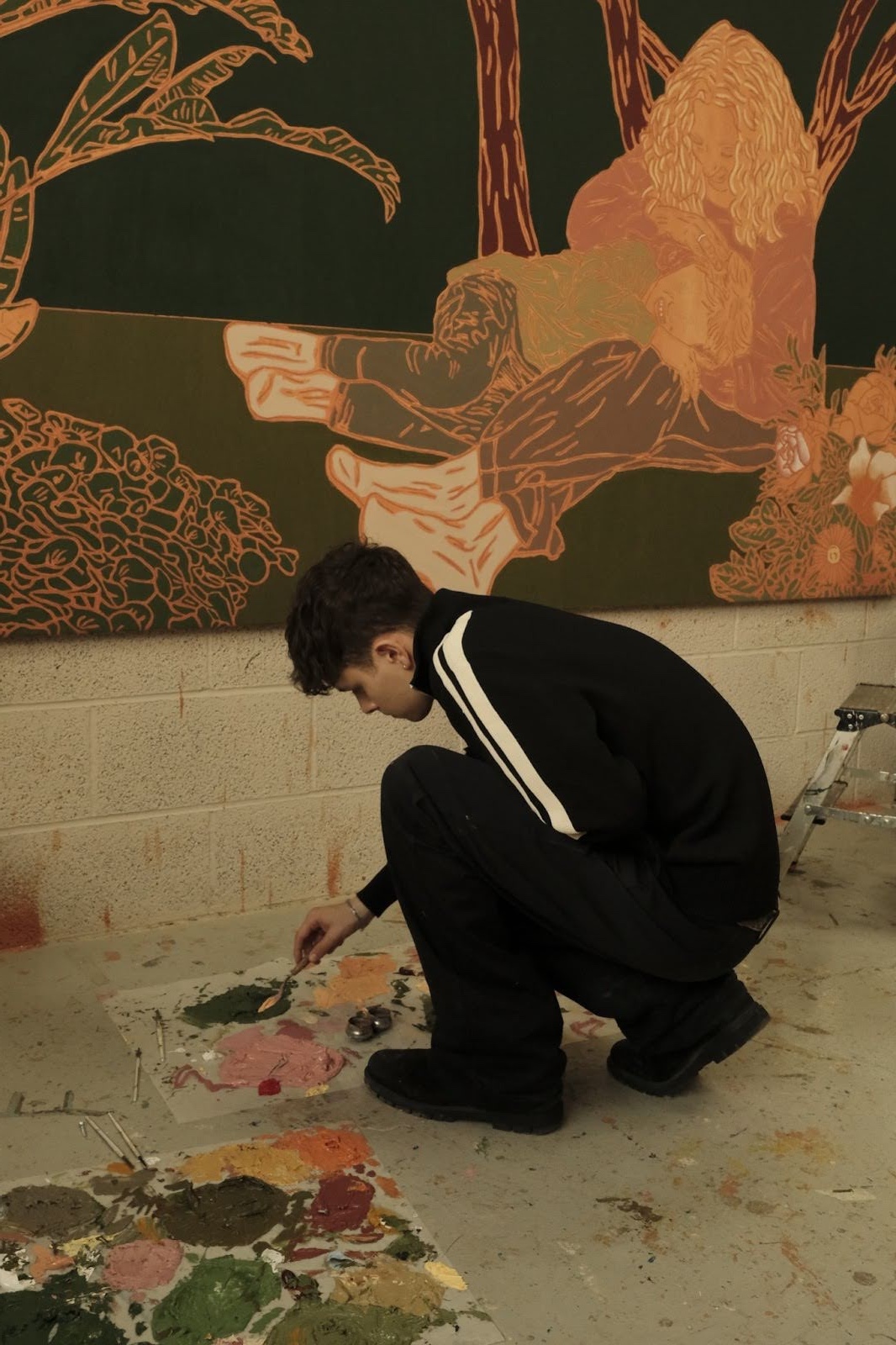

I think this sense of ambiguity you’ve created in the figures is super effective. As the audience, we can apply ourselves to the work completely. It’s like reading a book where the character traits of the protagonist are left quite open, and you can put yourself in their shoes.
That’s exactly the intention. There’s no context to the pieces, no branded clothes, no specific time, or specific place. And that's what I love so much about the ambiguity, how I’ve had people come up to me at shows and say, “This painting is my grandad, this painting is my wife, this is my daughter, etc.” People are able to take what they need and what they see from my paintings. I always say that I have a story to tell, but it's not the story, it's just a story. And because my work concerns the human experience, and all these human emotions, you don’t always know the story but you can always understand how it feels. When art is too prescriptive, it loses its magic.
Your work is evidently expressive, and stemming from the self but you’ve also done some commercial work in your career. Do you feel that there is a disconnect in creating fine art for commercial purposes?
Definitely, the intentions behind the two are very different. I’ve kind of turned down quite a bit of commercial work for that reason, partly time — if I’m painting, I want it to be something I want to paint. But on the other hand, there has been commercial work that I’ve enjoyed, like painting guests at an event for Miu Miu, where I got to practice painting in a completely different environment and timeframe.
Now you’ve done these super cool collabs with some major brands, but rewinding to your beginnings as a younger, less established artist, do you feel that there is enough support for aspiring creatives in the industry?
No, there’s literally no support. At the time, I remember thinking “Why isn’t anyone helping me out?” but in hindsight, it actually forced me to do things like throw my first exhibition at fifteen. And for bigger opportunities, and working with brands, I’m so glad those things are happening now instead of back then because I wouldn’t have been as ready back then – it forced me to realize that the work wasn’t there quite yet so I had to keep working and improving. I feel like I’m still very much in that phase of trying to get better and better and better, to put myself in the best position possible.
Experiencing how there aren’t many spaces for aspiring artists to showcase their work, inspired me to put together things like group shows. In 2021, I was working with Converse at the time, and pitched them the idea of an artist group show. They were down, so we were able to give fifteen artists the space to showcase their work. It gave a lot of these less established artists the opportunity to show their work in a more professional setting, and larger platform. And we did another one again about two months ago. I want to keep doing these things for sure, it’s building communities around art.
It's great that you’re creating creative spaces that didn’t exist for you when you were starting. I’m also curious to know, with time and practice of your art, has your creative process evolved?
Yes, definitely. I plan my pieces a lot more now. Especially for these larger ones, I plan them quite meticulously. A lot of the time, artists say that they won’t know what their end product will look like, but for me, I pretty much always know what my paintings are going to look like. The colors might change, but compositionally I know where everything is. And this is mostly because of my process with the line work — it being the very first layer I work with. Once I add the color blocking on, I can’t go back and add the lines back on top of it because it has to sit on the original layer of the canvas. I guess my paintings are kind of like coloring inside the lines. A lot of artists can let their painting process guide them to the final product, but I find that I need to be quite aware of my planning and end goal.
Nowadays, I also work on pieces simultaneously and it helps me build a cohesive body of work. For example, I’ll be working on a piece with a certain color, and then I’ll go and apply that same color to another piece that I’ve started. The look of one piece will end up influencing the other pieces around it.
That’s interesting, do you also feel that working on one painting sparks inspiration for the concept or subject matter of another painting?
Definitely, yes. For example, this piece I’m working on right now for Tate Modern, it’s influenced by another piece at the gallery, but one of the reasons I chose that piece is because it visually connects to my flower series paintings, so kind of referencing the other pieces I have worked on. Often, I’ll paint a certain subject matter, such as Mother and Daughter, and will continue that subject matter in multiple of my pieces.

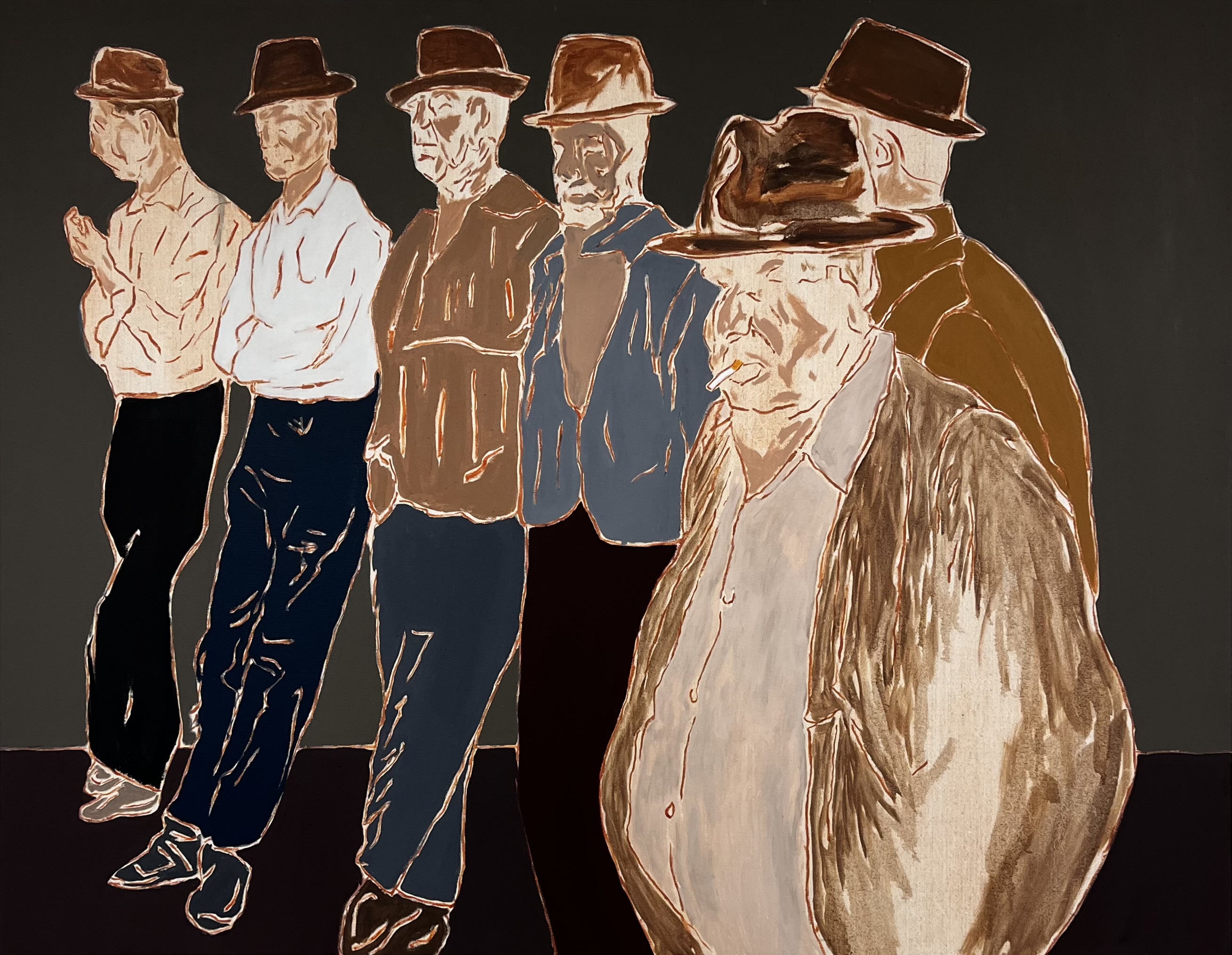

Speaking of your flower series, it really stands out to me because I noticed that while all your color blocking is flat, you’ve visually separated the flowers by painting them in gradients.
Yes, so the first of the flower series was a painting of just someone’s hands and then flowers, taking up the entire canvas. And this start of the series stemmed from an interest in looking at the psychology of relationships and gift giving. Specifically, how the gifting of flowers can actually mean so many things, like a romantic gift, or a celebratory thing, or a sympathy thing. So yes, I wanted to focus on the symbolism of flowers in human relationships and decided to give them some shading and gradient in order to give them a bit more life, while still not separating them too much from the flatness of my work. Within the composition of human figures, I really want the flowers to be the main focus, for them to stand out as much as possible.
And in these compositions of people, do you work from references?
A majority of the time, these aren’t real people I’m painting. Some compositions have a very loose photo reference of, for example, the form of the body while hugging. But I will say that I’m always taking mental notes of the way someone’s standing or sitting, or watching little altercations, or conversations between people on the tube. Subconsciously, there are scenes I see of the city that help inform my paintings. Especially in a big city like London, there’s always something going on and so these things stick with me and they translate into my work in one way or another.
We’ve talked about your work in the past, and its development to the present. Where do you see it going in the future?
So obviously, to keep painting is the main focus of my practice. But I also want to go into filmmaking, and I’m in the very early stages of working on a short film. I actually used to act when I was younger but realized that I might want to be on the other side of the camera. My paintings right now are sort of like cinema stills, so this short film I’m working on with a friend is based on my paintings. It deals with two sisters losing their mother, and surrounds the relationship of the two through quite a naive and child-like perspective.
I can see that translating beautifully. Your paintings capture scenes of life, and that is exactly the essence of film. Thanks for chatting with us!

Wet Dreams follows up on the 2022 edition of Mayrit, The Drowned Worlds, evidently appropriate themes for a biennial that takes its title from the 9th century name for Madrid which translates to “place of many waterways”. Unlike many biennials, which work to distinguish themselves thematically from their predecessors, Otero Verzier opted to build from the framework of the prior installment: a clever move that gestures to the priority of knowledge-building, social relation, and the biennial’s longer-term ambition to “position the Spanish capital as a creative focal point for emerging talent.”
Mayrit’s Curatorial Director, artist, and designer Joel Blanco, helps execute this vision. He notes that “the first edition was mostly for ourselves, the less established designers from Madrid who just wanted to have fun by creating their own events. We are gradually reaching a wider audience without forgetting about the independent, less mainstream proposals. Our approach was to fertilize the creative ground here by helping creatives develop their practice without the constraints of profit.”
Mayrit, which often takes on the celebratory and social spirit of a festival, is anchored by two notably strong institutional exhibitions: Wet Dreams, the title show at Madrid’s Centro Centro art center curated by Otero Verzier, and Espejito Espejito (“Mirror Mirror”) curated by architecture collective Grandeza Studio at the Museo de América at the western edge of the city center. Other venues, like the Bate Social Store which houses the Bienal’s design shop—a curated storefront with design objects selected from an open call — and the National Museum of Decorative Arts, which hosts Materia Computada — an exhibition curated by HyperStudio — atomize Mayrit’s itinerary across the city. “Mayrit has seeded many collaborations, and we are reaching places that were previously outside the scope of current design practice,” says Blanco.


Wet Dreams Deck Chair for Caliper's Editions Programme in collaboration with Mayrit Bienal. Designed by Miguel Leiro and Victor Clemente with Berit Levy and Caliper.
In Wet Dreams, Otero Verzier gathers an impressive array of work spanning film, industrial design, research, photography, and architecture, presenting contributions from peers, friends, allies, and a few students she has recently taught at the Design Academy Eindhoven. Artist collective La Cuarta Piel contributed documentation of their 2022 durational performance, “Spa Profundo,” in which they immersed performers in a hedonistic deluge of viscous marble extraction waste from a mine in the Vinalopó River valley near Alicante. A sample of their white mud pool inhabits the gallery in front of photos of limbs writhing in apparent delight: a visceral, if wry, critique of the slow violence of extractive capitalism. Models of Andres Jaque’s 2015 MoMA PS1 pavilion, the water-filtering “COSMO,” and the recent “Rambla Climate House,” designed with Miguel Mesa de Castillo, bring to the show an optimistic exuberance that points to architecture’s capacity to perform instrumentally at the scale of daily life. And in “Atlas de Plantas de Cuartos Oscuros en la Ciudad de Barcelona,” Pol Esteve Castelló presents floor plans of fifteen dark rooms in Barcelona with unlikely precision: sites of pleasure where social exchange often accompanies fluid exchange.
The show brings together a generation of new thinkers with urgent political and social preoccupations that reflect Madrid’s increasing centrality in design discourse. In recent years, Spanish designers have built an influential presence in American and European schools of architecture (Jaque, for instance, is the Dean of Columbia University’s Graduate School of Architecture, Preservation, and Planning). Only a few years ago, both Leiro and Otero Verzier were both living abroad — Leiro in New York and Otero Verzier in The Netherlands—and recently have returned to Spain, setting up in Madrid. Grandeza Studio (Amaia Sánchez-Velasco, Jorge Valiente Oriol, and Gonzalo Valiente Oriol), curators of Espejito Espejito, work between Madrid and Sydney. They typify the far-reaching interest in the country’s creative vanguard, and the way it is gathering anew in the country’s capital, fostering conversations that expand beyond conventional discourse.

Video triptych for Espejito Espejito featuring 'Los Escombros' by La Escuela Nunca y los Otros Futuros, 'America Megabyte' by Nmenos1 and 'Sabe Dios' by Julia Irango and Jorge Nieto (with Ana Moure and Cesar Fuertes). Photo by Asier Rua.
Espejito Espejito develops from ideas articulated by Argentinian anthropologist Rita Segato, and from Peruvian sociologist Aníbal Quijano’s argument that the very idea of Europe is predicated on the European “invention” (rather than discovery) of America, and its subsequent colonization. Grandeza Studio invites artists—many of them from Central and South America and their diaspora communities—whose work uses the notion of the mirror to “redirect its distorting power.” That this takes place in Madrid’s Museo de América, what the curators call a “historical guarantor and archival reservoir of the Eurocentric autofiction,” is noteworthy. The museum’s new director, Andrés Gutiérrez Usillos, was appointed in 2023 and has declared his ambition to decolonize its collection. Espejito Espejito is housed in a gallery that previously held an exhibition titled El Hombre (first installed in 1994), and vestiges of it remain in a savvy curatorial move that point to the discursive distance between old guard and new.
Some interventions from the show’s artists have further highlighted precisely this sort of friction. Earlier this year, Colombia’s Minister of Culture made a formal request to repatriate the Quimbaya artifacts—a part of the Museo’s collection—which has so far been declined by the Spanish government. Colombian artist Juan Covelli synthesized prospective new artifacts using a generative adversarial network (GAN) trained on images of the Quimbaya Treasure in an attempt at symbolic repatriation. Next to the vitrine housing Covelli’s work is a wall label authored by the Museo, clarifying that the participating artists’ views “do not necessarily represent the opinion of the institution,” and inviting visitors to see the actual relics on the building’s second floor.
“Espejito Espejito” includes vital contributions from Martine Gutierrez (“HIT MOVIE: Vol. 1”), Tatyana Zambrano and Hernán Rodriguez (“Banana Valley”), and Naomi Rincón Gallado (“Sangre Pesada”), organized in an improvised scenography composed of scaffolding and silver curtains devised by the show’s curators. The exhibition takes big risks that pay off. It is radical in the way that it works from within and alongside a museum grappling with its colonial legacy live, out in the open. Perhaps it is through dissident guest programming like this that the institution can advance beyond its own burdensome history. On a quiet day, I even observed the gallery docents playing “UNKRNS: Beyond the Entrepreneurial Spell,” a video game made by artists Diego Morera and Sebastián Lambert. Indeed, “Mayrit aspires to build more bridges with Spanish-speaking countries to give them a platform here as well,” says Blanco.


Tapiz, tapiz, 1.000 millones, please (2024) by Virginia Sosa Santos, Sebastián Lambert and Diego Morera & Banana Valley (2022) by Tatyana Zambrano and Hernán Rodríguez
Miguel Leiro, Mayrit’s Founder and Director, has cited La Movida Madrileña, the explosive creative scene of the 1980s that followed Francisco Franco’s death in 1975, as a reference for the milieu he’s interested in cultivating now. In that time, figures like Pedro Almodovar and Rossy da Palma emerged alongside new cultural dynamics and amidst a new openness around sex and glamour. Mayrit’s programming subtly nods to that moment every now and then. Its opening night party (co-organized by the local music incubator Los Invernaderos) was hosted at Sala El Sol, a venue where Almodovar and bands like Radio Futura would hang out and play. Leiro’s father, a sculptor who emerged from the same artistic movement as Marina Otero Verzier’s (who is a painter), would spend time there in the 1980s as well, descending its red spiral staircase as a new crowd did for Mayrit’s inauguration this spring. As this latest crop of young madrileños danced into the late hours of the night, sweat and drink perhaps conjured yet more novel visions of a cultural scene emerging anew. Evidently, currents still flow in Madrid’s underground.
Wet Dreams runs until August 25th at Centro Centro. Espejito Espejito runs until November 24th at the Museo de América. The full program for the 2024 Mayrit Bienal can be found at mayrit.org.

Check out photos from the opening night below and put your bids in here. The Artist and the Cigar Box online auction.




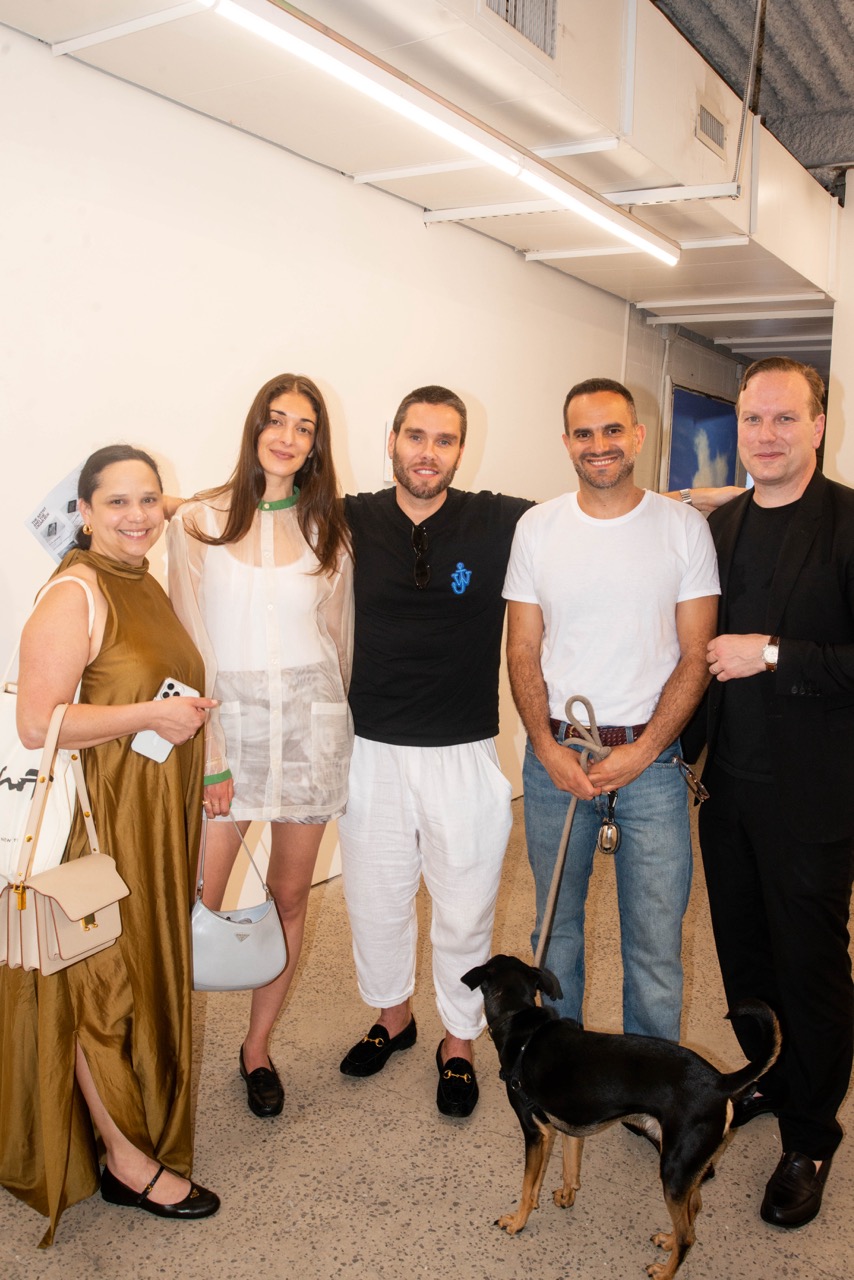






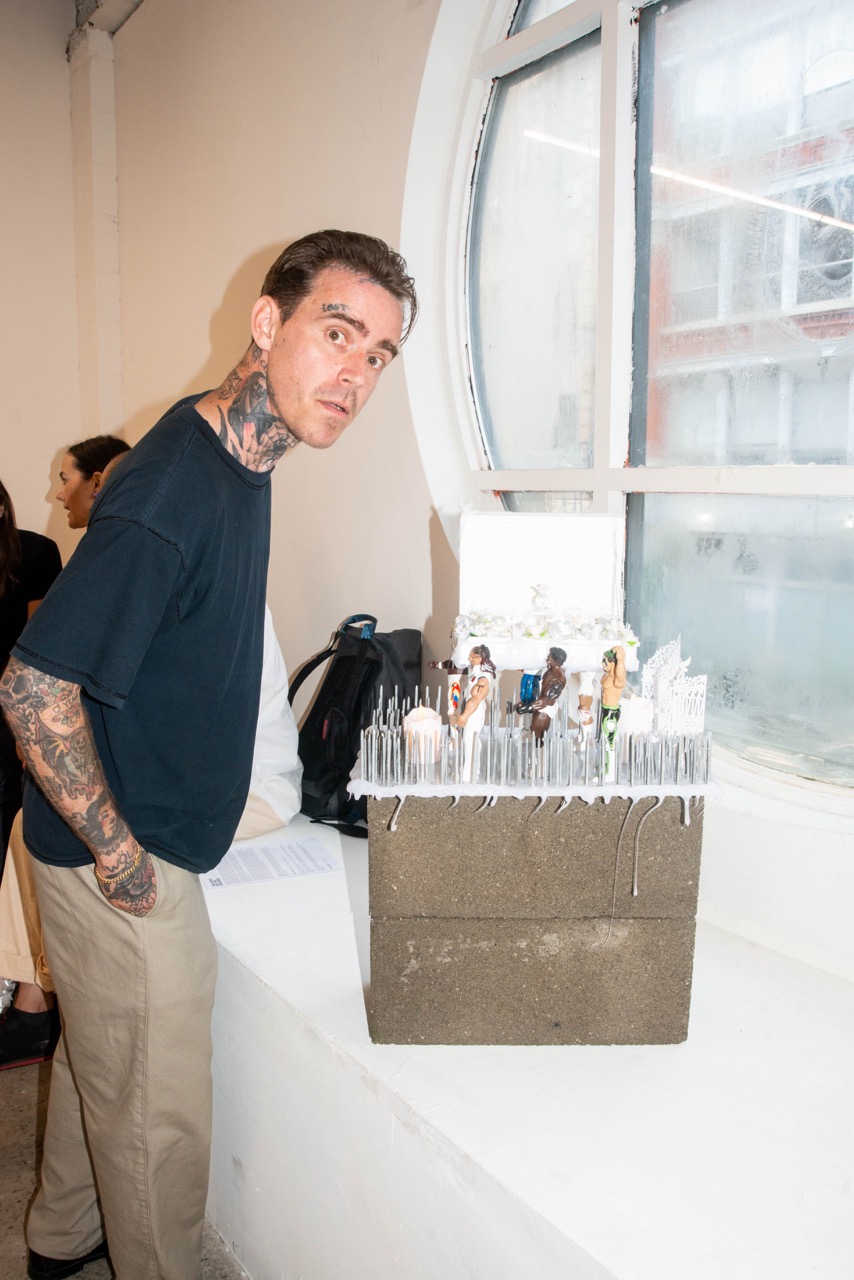
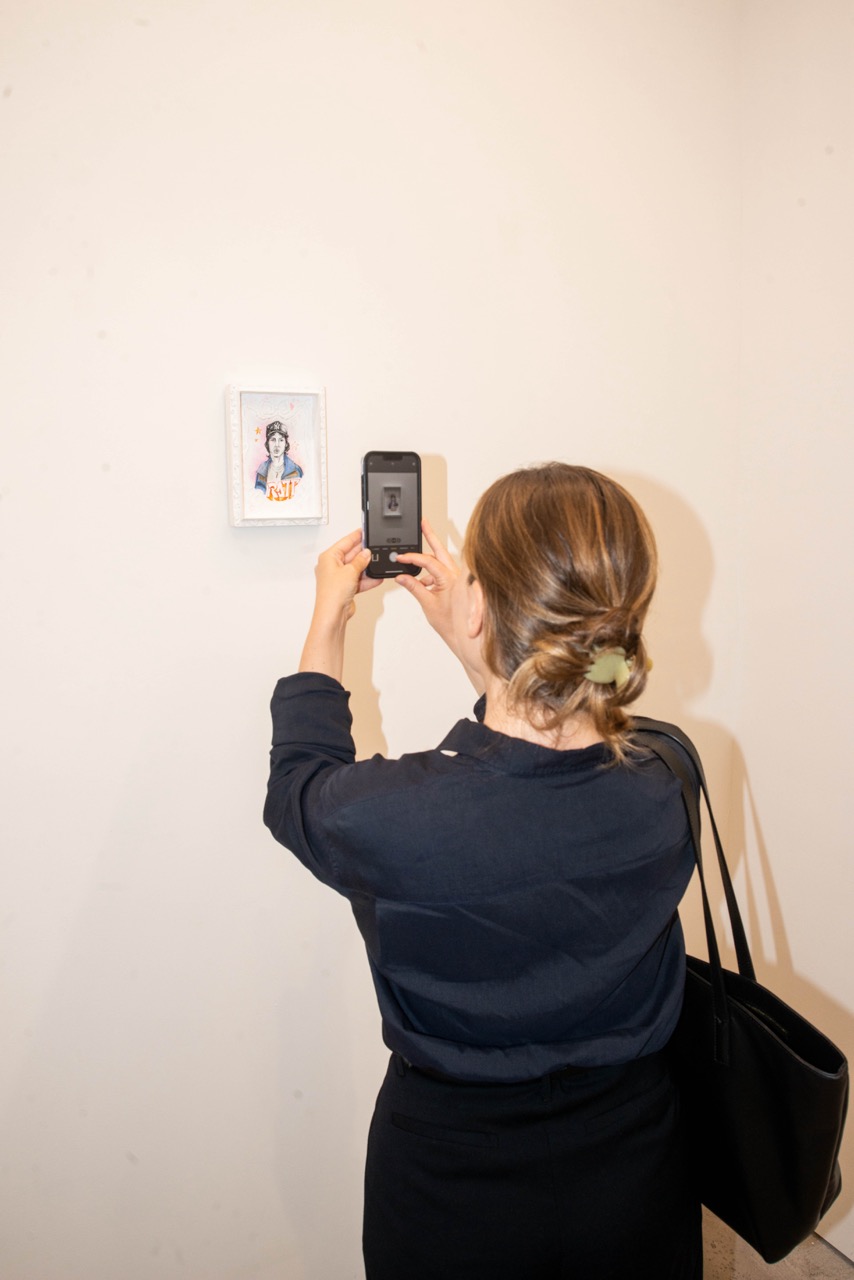

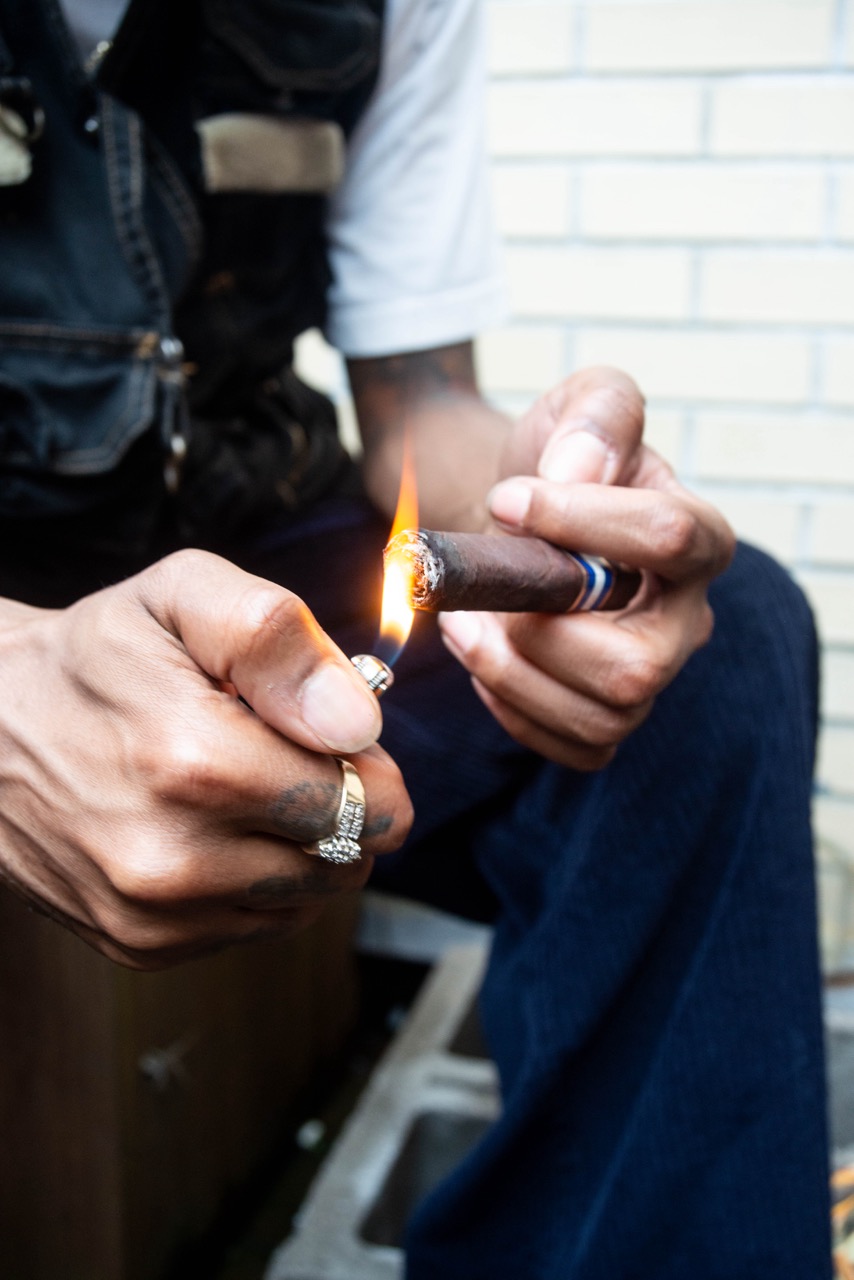





















The Artist and the Cigar Box is on view online through June 30th.